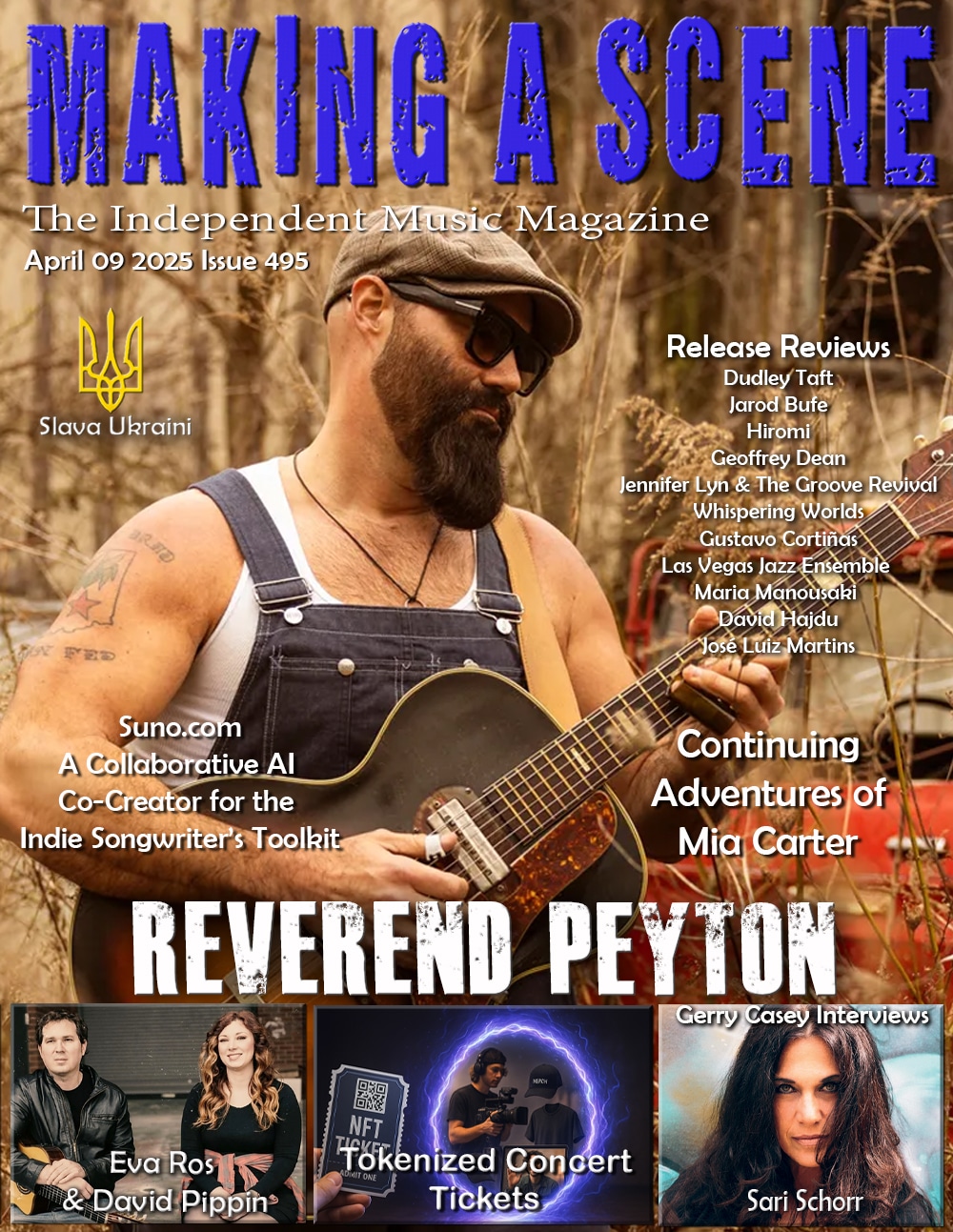Andrea Wolper Wanderlust
 Andrea Wolper
Wanderlust
Moonflower Music
Not being aware of adventurous vocalist Andrea Wolper until now, this writer did what he usually does, checked her accompanists and her background. Both were impressive. In terms of the latter, she began like most do, by singing standards, moving on to big band and then to free jazz with icon William Parker. One need not go much further but consider her accompanists here that run the gamut from straight-ahead to free. Her longtime backing trio is pianist John Di Martino, bassist Ken Filiano. And drummer Michale Ta Thompson. Versatile NYC favorite Charlie Burnham is on violin and the redoubtable Jeff Lederer is not only on clarinet and flute but co-produced Wanderlust. Convinced yet? It’s been thirteen years since Volper’s last album, but she is a busy multi-talented individual who not only constantly tours but is an accomplished writer and poet with published works, and an educator of voice, songwriting, and jazz performance. That alone leaves you plenty to research if you desire. Let’s go to the music.
Wolper takes credit alone or as a co-writer in seven of this dozen, covering a wide swath of artists in the others from Ray Charles to Abbey Lincoln to Carole King and Sting. She makes this comment in the liners, “…singing improvisational music – wherever it falls along the great jazz continuum—is freeing, more like flying than walking. And who doesn’t want that feeling?” With that inspirational commentary, let’s take her originals first, though the covers are equally as intriguing. The first original appearing is “Sobe E Desce” (Portuguese for “up and down”). She sings the wordless melody in synch with Lederer’s flute before the group engages in a trading frenzy. “Eventide” is another wordless tune, rather mysterious and pensive with Burnham’s violin and Filiano’s gorgeous arco featured. In “Still Life” she duets with DiMartino playing elegantly in this sad ballad that paints loneliness vividly (“Everything’s still here but you.”). Her breathy, emotive vocal shows a masterful command of both phrasing and dynamics.
Wolper penned “The Nature of Life” right before the onset of the pandemic. You’ll recognize the phrase “Life springs eternal” in here, a droning tune that she sings most ethereally with spoken word mixed in. The instrumentation consists of just shruti box (played by Wolper and sounding akin to a harmonium) drums, and violin. This is definitely “out.” On “Nevermore” Wolper renders the tune in a bluesy, weathered voice dueting just with bassist Filiano, who is stellar here, to conjure that eerie feeling of Edgar Allan Poe’s iconic “The Raven.” She goes even further with total spontaneous improvisation together with her core trio on “Cisluna.” Her standout closer is wittily titled “The Winter of Our Content” and has the most straight ahead, standard-like feel of her originals. It’s an uplifting song toasting love’s endurance, borrowing a bit from Shakespeare in the lyrics, perhaps citing that one positive aspect of those isolated pandemic months, spending more time with a loved one – “Although at times we’re tempest tossed/The love we found we’ve never lost/For ‘neath that starry firmament/There hangs a tale most excellent/Of how we fell/The Winter of Our Content.”
Opener “Light Out of Darkness” by Ray Charles and Rick Ward from 1965 may nod to the emerging from the pandemic as well. It certainly doesn’t qualify as a political statement unless as a hopeful statement in these chaotic times. She delivers it as a love song instead, with Burnham’s violin and Filiano’s arco merging again to create an interesting harmonic backdrop. Burnham also gets an extended turn. She transforms Wayne Carson’s country “Dog Day Afternoon” into a sensual jazz ballad with Burnham again taking the soloing honors. Abbey Lincoln’s “The Music Is the Magic” proves to be a strong harmonic blend of voice, clarinet, and violin – not the usual fare found in a jazz vocal album. Similarly, violin, flute, and arco bass blend dissonantly rather than harmoniously in her treatment of Sting’s “I Burn for You.” The group proves their mettle again in a distinctly pop number, Carole King’s “Been to Canaan,” which becomes barely recognizable in this jazz interpretation, buoyed by Lederer’s flute.
This is as creative a vocal jazz album as this writer has heard recently. This rewarding listen is an early candidate for year-end “Best Of” lists.
Andrea Wolper
Wanderlust
Moonflower Music
Not being aware of adventurous vocalist Andrea Wolper until now, this writer did what he usually does, checked her accompanists and her background. Both were impressive. In terms of the latter, she began like most do, by singing standards, moving on to big band and then to free jazz with icon William Parker. One need not go much further but consider her accompanists here that run the gamut from straight-ahead to free. Her longtime backing trio is pianist John Di Martino, bassist Ken Filiano. And drummer Michale Ta Thompson. Versatile NYC favorite Charlie Burnham is on violin and the redoubtable Jeff Lederer is not only on clarinet and flute but co-produced Wanderlust. Convinced yet? It’s been thirteen years since Volper’s last album, but she is a busy multi-talented individual who not only constantly tours but is an accomplished writer and poet with published works, and an educator of voice, songwriting, and jazz performance. That alone leaves you plenty to research if you desire. Let’s go to the music.
Wolper takes credit alone or as a co-writer in seven of this dozen, covering a wide swath of artists in the others from Ray Charles to Abbey Lincoln to Carole King and Sting. She makes this comment in the liners, “…singing improvisational music – wherever it falls along the great jazz continuum—is freeing, more like flying than walking. And who doesn’t want that feeling?” With that inspirational commentary, let’s take her originals first, though the covers are equally as intriguing. The first original appearing is “Sobe E Desce” (Portuguese for “up and down”). She sings the wordless melody in synch with Lederer’s flute before the group engages in a trading frenzy. “Eventide” is another wordless tune, rather mysterious and pensive with Burnham’s violin and Filiano’s gorgeous arco featured. In “Still Life” she duets with DiMartino playing elegantly in this sad ballad that paints loneliness vividly (“Everything’s still here but you.”). Her breathy, emotive vocal shows a masterful command of both phrasing and dynamics.
Wolper penned “The Nature of Life” right before the onset of the pandemic. You’ll recognize the phrase “Life springs eternal” in here, a droning tune that she sings most ethereally with spoken word mixed in. The instrumentation consists of just shruti box (played by Wolper and sounding akin to a harmonium) drums, and violin. This is definitely “out.” On “Nevermore” Wolper renders the tune in a bluesy, weathered voice dueting just with bassist Filiano, who is stellar here, to conjure that eerie feeling of Edgar Allan Poe’s iconic “The Raven.” She goes even further with total spontaneous improvisation together with her core trio on “Cisluna.” Her standout closer is wittily titled “The Winter of Our Content” and has the most straight ahead, standard-like feel of her originals. It’s an uplifting song toasting love’s endurance, borrowing a bit from Shakespeare in the lyrics, perhaps citing that one positive aspect of those isolated pandemic months, spending more time with a loved one – “Although at times we’re tempest tossed/The love we found we’ve never lost/For ‘neath that starry firmament/There hangs a tale most excellent/Of how we fell/The Winter of Our Content.”
Opener “Light Out of Darkness” by Ray Charles and Rick Ward from 1965 may nod to the emerging from the pandemic as well. It certainly doesn’t qualify as a political statement unless as a hopeful statement in these chaotic times. She delivers it as a love song instead, with Burnham’s violin and Filiano’s arco merging again to create an interesting harmonic backdrop. Burnham also gets an extended turn. She transforms Wayne Carson’s country “Dog Day Afternoon” into a sensual jazz ballad with Burnham again taking the soloing honors. Abbey Lincoln’s “The Music Is the Magic” proves to be a strong harmonic blend of voice, clarinet, and violin – not the usual fare found in a jazz vocal album. Similarly, violin, flute, and arco bass blend dissonantly rather than harmoniously in her treatment of Sting’s “I Burn for You.” The group proves their mettle again in a distinctly pop number, Carole King’s “Been to Canaan,” which becomes barely recognizable in this jazz interpretation, buoyed by Lederer’s flute.
This is as creative a vocal jazz album as this writer has heard recently. This rewarding listen is an early candidate for year-end “Best Of” lists.
- Jim Hynes
Discover more from Making A Scene!
Subscribe to get the latest posts sent to your email.














































